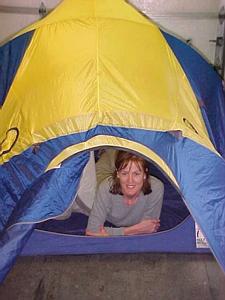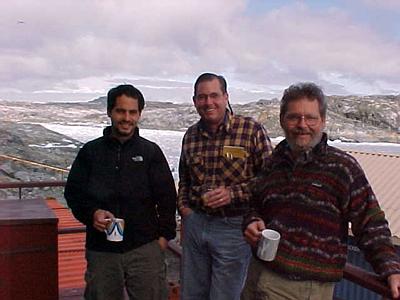
|
|
10 January, 2000
Hi all!
First let me say, if you have already read 09Jan journal entry, please
reread it as I had some...shall we say...typos and I had to resend it to
fix them. Those of you who already saw my mistakes, ha-ha! I am going to
have to quit writing at 1 and 2 in the morning!! Well, today was another
great day with lots of new and interesting stuff. I was able to spend all
morning working on stuff I came down here to do. I have started to run
water samples on dissolved oxygen, pH, turbidity, water temperature, and
ambient temperature. I am not sure where exactly I will collect the
samples. Right now, I am using the pump house which has a spout with a
hose that pumps in fresh ocean water. This makes collection really easy,
but I am thinking I may want to look at the same tests at different water
depths. Would be interesting to compare the results I think. Right now,
easy is OK with me...the water is a cool 5 degrees Celcius. I also am
getting lined up to run the solid standard tests on the station field
flourometer. Another unit just arrive to be included in the tests. It will
be pretty cut and dry; I just need time allotted to run the tests. Right
now there are too many interruptions with meetings and training sessions.
Speaking of training sessions, this afternoon we had to attend Boating
Class I. We have to pass a written test and receive training in order to
use the zodiacs. Initially, we watched a really interesting film about
the do's and don'ts of boating in this area. The weather can change on
you very quickly and there are many of safety rules. They taught us how
to survive at any one of the neighboring islands if weather or other event
prohibits you from returning to station. Events like equipment failure,
stormy winds, ice drifts that trap you, etc. are some of the things that
can happen. This sounded pretty serious so I was front and center, paying
close attention. There is also survival caches clearly mapped out on the
islands. Boaters can easily find these series of barrels that contain a
tent, sleeping bags, stove, food, water, and other necessary items useful
for hunkering down and waiting out a storm. You also never travel anywhere
without a radio and before telling communications where you are going and
what time you plan to return. We had to practice lighting the stove and
constructing the tent. It is real easy to do in a big garage. The trick
is doing it out in high wind and freezing temperatures. Tomorrow is
Boating Class II. This session takes us out in the boat and we have to
actually steer it and properly operate it in ice patches, properly land
it, etc. I am sure I will have something "interesting" to tell you
tomorrow. Later tonight we are all going to watch a slide show
presentation by our visiting media guys. They brought a collection of
their photographs from very interesting and exotic places. I am attaching
their photo for you to see. They have been a fun group of guys to explore
this place with.
More details tomorrow!
-Mimi

Here I am in a typical survival tent we had to construct. These are stored in caches at most of the neighboring islands. There is lots of room inside!!

Jim LoScalzo is a photographer for U.S. News and World Report. Charles Petit, also with U.S. News and World Report, will write an story to compliment Jim's photos. Gary Braasch is in Antarctica on a media travel grant and support from the International Wildlife magazine.
Contact the TEA in the field at
.
If you cannot connect through your browser, copy the
TEA's e-mail address in the "To:" line of
your favorite e-mail package.
|
